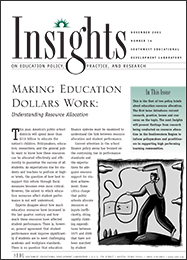Making Education Dollars Work: Understanding Resource Allocation
Introduction
This year, America's public school districts will spend more than $310 billion to educate the nation's children. Policymakers, educators, researchers, and the general public want to know how these resources can be allocated effectively and efficiently to guarantee the success of all students. As expectations rise for students and teachers to perform at higher levels, the question of how best to support this reform through fiscal measures becomes even more critical. However, the extent to which education resources affect student performance is not well understood.
Experts disagree about how much education resources have increased in the last quarter century and how much these resources have affected student performance. There is, however, general agreement that student performance must improve significantly if students are to meet challenging academic and workplace standards. There is no question that education finance systems must be examined to understand the link between resource allocation and student performance.
 Current attention in the school finance policy arena has focused on the continuing rise in performance standards and the expectations for adequate resource support for student achievement. Some critics charge that public schools allocate resources or inputs inefficiently, citing rapidly climbing expenditures between 1975 and 2000 that have not been matched by student achievement gains during the same time period. Educational outcomes - measured by student test performance - have remained the same or even declined in some academic subjects during the last quarter century (Hanushek, 1996). Other analysts report that inflation-adjusted spending has only maintained the overall level of per-pupil resources.
Current attention in the school finance policy arena has focused on the continuing rise in performance standards and the expectations for adequate resource support for student achievement. Some critics charge that public schools allocate resources or inputs inefficiently, citing rapidly climbing expenditures between 1975 and 2000 that have not been matched by student achievement gains during the same time period. Educational outcomes - measured by student test performance - have remained the same or even declined in some academic subjects during the last quarter century (Hanushek, 1996). Other analysts report that inflation-adjusted spending has only maintained the overall level of per-pupil resources.
While many states specify high performance goals for all students, all too often measured performance falls short of expectations. For example, on the National Assessment of Education Progress (NAEP), an average of about 25 percent of students perform at or above proficiency levels on mathematics and about 32 percent perform at those levels on reading. Other NAEP test takers are at or below basic levels. This is a disappointing result for a nation that expects most students to master the core subjects of mathematics and reading. Current evidence from other assessments, such as the Third International Mathematics and Science Study and various state criterion-referenced tests, show similar performance results. Rapid and dramatic change—doubling or tripling the percentage of students attaining proficiency—calls for new instructional strategies and intensified efforts to help every student learn. However, it is unlikely that revenues will double or triple in the next few years, so performance improvement also will require better approaches to allocating resources for teaching and learning.
The purpose of this policy brief is to introduce state policymakers to information about current practice and research on education resource allocation and to heighten awareness of the issues and concerns regarding this topic. This issue of Insights begins with a general description of patterns in education resource allocation over time, followed by a brief review of research about the relationship between resources and student performance. The next section provides an overview of tools to examine resource allocation that can shed new light on how resources can be allocated and used more effectively. This issue concludes by exploring topics state policymakers will face as they seek ways to allocate resources to support high standards and improved student performance.
Next Page: Resource Allocation: A Stable Pattern Over Time

